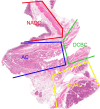The Brescia International Multidisciplinary Consensus Guidelines on the Optimal Pathology Assessment and Multidisciplinary Pathways of Non-Pancreatic Neoplasms in and Around the Ampulla of Vater (PERIPAN)
- PMID: 40729532
- PMCID: PMC12463731
- DOI: 10.1002/ueg2.70074
The Brescia International Multidisciplinary Consensus Guidelines on the Optimal Pathology Assessment and Multidisciplinary Pathways of Non-Pancreatic Neoplasms in and Around the Ampulla of Vater (PERIPAN)
Abstract
Importance: The lack of multidisciplinary workflow guidelines and clear definitions and classifications for neoplasms in and around the ampulla of Vater results in inconsistencies affecting patient care and research.
Objective: The PERIPAN international multidisciplinary consensus group aimed to standardize the multidisciplinary diagnostic workflow and achieve consensus on definitions and classifications in order to ensure proper classification and optimal diagnostic assessment and consequently to improve patient care and future research.
Design: An international team of 43 experts (pathologists, surgeons, radiologists, gastroenterologists, oncologists) from 12 countries identified knowledge gaps, reviewed 37061 articles, and proposed recommendations using the Scottish Intercollegiate Guidelines Network methodology (SIGN), including the Delphi methodology and the AGREEII tool for quality assessment and external validation.
Results: The 38 consensus questions and 51 recommendations provide guidance on the following key aspects: I. More specific anatomic criteria for the definition of what qualifies as "ampullary" neoplasms, their distinction from duodenal and common bile duct tumors, and clinicopathologic characteristics of anatomic subsets; II. Avoidance of the confusing term "periampullary" for final classification; III. Refined definitions of intestinal, pancreatobiliary and mixed subtypes, and introduction of rare histologic subtypes; IV. The use and limitations of immunohistochemical and molecular profiling; V. Biopsy acquisition; VI. Clinical information required for accurate pathology assessment of biopsies and ampullectomy specimens; VII. Key items to be included in pathology reports of endoscopic specimens.
Conclusions and relevance: Recognition of the Brescia PERIPAN guidelines will allow a more accurate classification of true ampullary cancers and their differentiation from other "periampullary" tumors. This will have significant implications for endoscopic interpretation and management, staging, pathologic diagnosis and therapeutic evaluation as well as oncologic treatment of various anatomic and histologic subsets of ampullary tumors. This will enhance the quality of both clinical care and future research in this complex medical field.
Keywords: ampulla of Vater; bile duct tumor; classification; consensus; duodenal tumor; guidelines; neoplasm; pancreatobiliary; periampullary.
© 2025 The Author(s). United European Gastroenterology Journal published by Wiley Periodicals LLC on behalf of United European Gastroenterology.
Conflict of interest statement
The authors declare no conflicts of interest.
Figures






References
-
- Ferlay J., Ervik M., Lam F., et al., Global Cancer Observatory: Cancer Today. International Agency for Research on Cancer, https://gco.iarc.fr/today.
-
- Neoptolemos J. P., Moore M. J., Cox T. F., et al., “Effect of Adjuvant Chemotherapy With Fluorouracil Plus Folinic Acid or Gemcitabine vs Observation on Survival in Patients With Resected Periampullary Adenocarcinoma: The ESPAC‐3 Periampullary Cancer Randomized Trial,” JAMA 308, no. 2 (2012): 147–156, 10.1001/jama.2012.7352. - DOI - PubMed
-
- Adsay V., Ohike N., Tajiri T., et al., “Ampullary Region Carcinomas: Definition and Site Specific Classification With Delineation of Four Clinicopathologically and Prognostically Distinct Subsets in an Analysis of 249 Cases,” American Journal of Surgical Pathology 36, no. 11 (2012): 1592–1608, 10.1097/PAS.0b013e31826399d8. - DOI - PubMed
Publication types
MeSH terms
Grants and funding
LinkOut - more resources
Full Text Sources
Medical

